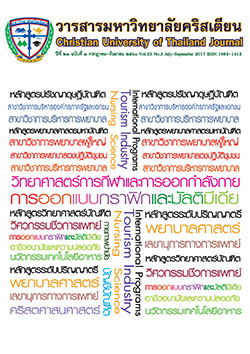ผลของการอ่านแบบเน้นมโนทัศน์ ในการสอนวรรณกรรมคริสเตียน ของผู้เรียนภาษาอังกฤษเป็นภาษาที่สอง
บทคัดย่อ
การวิจัยนี้มีวัตถุประสงค์เพื่อ 1) ศึกษาผลของการสอนภาษาอังกฤษแบบเน้นมโนทัศน์ที่มีต่อระดับความเข้าใจในการอ่านวรรณกรรมคริสเตียนภาษาอังกฤษของผู้เรียนภาษาอังกฤษเป็นภาษาที่สอง 2) ศึกษาผลของการสอนภาษาอังกฤษแบบเน้นมโนทัศน์ที่มีต่อความเข้าใจในการอ่านวรรณกรรมประเภทต่าง ๆ ของผู้เรียนภาษาอังกฤษเป็นภาษาที่สอง และ 3) ศึกษาความสัมพันธ์ของผลต่างของระดับความเข้าใจในการอ่านและของความเข้าใจในการอ่านวรรณกรรมคริสเตียนประเภทต่าง ๆ งานวิจัยนี้มีตัวอย่างคือนักศึกษาชั้นปี 2 ของมหาวิทยาลัยเอกชนแห่งหนึ่งในกรุงเทพมหานครจำนวน 21 คน การทดลองใช้เวลาทั้งสิ้น 12 สัปดาห์ ในช่วงภาคการศึกษาที่ 2 ปีการศึกษา 2558 สถิติที่ใช้วิเคราะห์คือ ค่าเฉลี่ย ค่าเบี่ยงเบนมาตรฐาน ค่าทดสอบที และค่าความสัมพันธ์เพียร์สัน
ผลการวิจัยพบว่า 1) คะแนนเฉลี่ยของผลการทดสอบความเข้าใจในการอ่านวรรณกรรมคริสเตียนของตัวอย่างหลังการทดลองสูงกว่าก่อนการทดลองอย่างมีนัยสำคัญทางสถิติที่ระดับ 0.05 ในทุกระดับความเข้าใจ ได้แก่ระดับตัวอักษร ระดับอนุมาน และระดับการสร้างความรู้ 2) คะแนนเฉลี่ยของผลการทดสอบความเข้าใจในการอ่านวรรณกรรมคริสเตียนประเภทต่างๆ หลังการทดลองสูงกว่าก่อนการทดลองอย่างมีนัยสำคัญทางสถิติที่ระดับ 0.05 ในทุกประเภทวรรณกรรม อันได้แก่ ข้อความจากพระคริสตธรรมคัมภีร์ บทความคริสตศาสนศาสตร์พันธสัญญาเดิม และบทความคริสตศาสนศาสตร์พันธสัญญาใหม่ 3) คะแนนเฉลี่ยที่แตกต่างระหว่างก่อน การทดลองและหลังการทดลองในระดับของความเข้าใจในการอ่านข้อความจากพระคริสตธรรมคัมภีร์ มีความสัมพันธ์กับคะแนนเฉลี่ยที่แตกต่างระหว่างก่อนและหลังการทดลองในระดับของความเข้าใจในการอ่านระดับอื่น และในความเข้าใจในการอ่านวรรณกรรมประเภทต่างๆ อย่างมีนัยสำคัญทางสถิติที่ระดับ 0.05
จากผลการวิจัยเห็นควรให้นำการสอนภาษาอังกฤษแบบเน้นมโนทัศน์มาใช้ในการสอนวรรณกรรม คริสเตียนให้กับผู้เรียนภาษาอังกฤษเป็นภาษาที่สองเพื่อพัฒนาความเข้าใจในการอ่านทั้งระดับตัวอักษร ระดับอนุมาน และระดับการสร้างความรู้ และในทุกประเภทวรรณกรรมคริสเตียน อีกทั้งความเข้าใจในการอ่านข้อความจากพระคริสตธรรมคัมภีร์เป็นประเภทวรรณกรรมพื้นฐานที่มีความสัมพันธ์กับทุกระดับความเข้าใจและในความเข้าใจในการอ่านทุกประเภทวรรณกรรมอีกด้วย อย่างไรก็ตาม การวิจัยครั้งต่อไปควรเพิ่มระยะเวลาทดลองเพื่อให้ได้ข้อมูลที่ลุ่มลึกยิ่งขึ้น และเพิ่มการวิจัยเชิงคุณภาพเพื่อวิเคราะห์ร่วมกับผลที่ได้จากการวิจัยเชิงปริมาณด้วย
เอกสารอ้างอิง
Brown, H. D. (2001). Teaching by principles: an interactive approach to language pedagogy.New York: Pearson Education.
Guthrie, J. T., and Cox, K. E. (2001). "Classroom Conditions for Motivation and Engagement in Reading" . Educational Psychology Review 13(3): 283-302.
Guthrie, J. T., Mason-Singh, A., & Coddington, C. S. (2012). Instructional effects of concept-oriented reading instruction on motivation for reading information text in middle schoolAdolescents' Engagement in Academic Literacy (pp. 155-215). University of Maryland, Department of Human Development and Quantitative Methodology. Retrieved from https://cori.umd.edu/research-publications/2012_adolescents_ engagement_ ebook.pdf.
Guthrie, J. T., Meter, P. V., McCann, A. D., & Wigfield, A. (1996). Growth of literacy engagement: changes in motivations and strategies during concept-oriented reading instruction. Reading Research Quarterly, 31(3).
Guthrie, J. T., Wigfield, A., & Klauda, S. L. (2012). Adolescents' engagement in academic literacy (pp. 352). Retrieved from www.corilearning.com/research-publications
Guthrie, J. T., Wigfield, A., & Perencevich, K. C. (2004). Motivating reading comprehension: concept-oriented reading instruction. New Jersey: Mahwah.
Guthrie, J. T., Wigfield, A., & You, W. (2012). Instructional Contexts for Engagement and Achievement in Reading. Handbook of Research on Student Engagement (pp. 601). DOI 10.1007/978-1-4614-2018-7_29. Retrieved from www.corilearning.com/research-publications.
Haley, M. H., & Ausin, T. Y. (2004). Content-based second language teaching: An interactive approach. USA: Pearson Education, Inc.
Jordan, R. R. (1997). English for academic purposes: A guide and resource book for teachers. New York: Cambridge University.
Kiriratnitikul, J. (2013). A development of electronic learning materials for English reading for specific purpose at the Bangkok Institute of Theology. Faculty of Education. Chulalongkorn University, Bangkok, Thailand.
Kiriratnitikul, J. (2014). Effects of Christian Theological English Reading Using Concept-Oriented Reading Instruction to Enhance Reading Comprehension and Reading Motivation of Undergraduate Students. (Master), Chulalongkorn University, Chulalongkorn University.
Klauda, S. L., & Guthrie, J. T. (2012). Information Text Comprehension in Adolescence: Vital Cognitive ComponentsAdolescents' Engagement in Academic Literacy (pp. 103-154). University of Maryland, Department of Human Development and Quantitative Methodology.
Klauda, S. L., Wigfield, A., & Cambria, J. (2012). Struggling readers' information text comprehension and motivation in early adolescenceAdolescents' Engagement in Academic Literacy (pp. 295-351).University of Maryland, Department of Human Development and Quantitative Methodology. Retrieved from https://cori.umd.edu/research-publications/2012_adolescents_engagement_ ebook.pdf
McPeake, J. A., & Guthrie, J. T. (Producer). (2012). Thematic design for literacy engagement. [PowerPoint Presentation]
Moffett, S. H. (2005). A history of Christianity in Asia: Vol.2 (1500-1900) (Vol. 2). New York: Orbis Books, Maryknoll.
Pierson, C., Dickerson, L., & Scott, F. (2010). Exploring theological English, teacher's guide. Great Britain: Piquant Editions.
Richards, J. C., & Rodgers, T. S. (2001). Approaches and methods in language teaching.USA: Cambridge University Press.
Richardson, J. S., & Morgan, R. F. (2003). Reading to learn in the content areas. CA: Wadsworth/Thomson Learning.
Snow, C. (2004). Defining comprehension. RAND Reading for Understanding Reading Forum. 1-21. [Online]. Retrieved December 2015, from: https://www.pbs.org/teacherline/courses.
Worakitsawat, J. (2007). Effects of concept-oriented English reading instruction on reading comprehension and reading self-efficacy of lower secondary school students. (Master), Chulalongkorn University.



